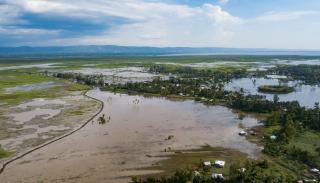
Breadcrumbs navigation
Climate change on a fluid earth: The movement of matter in the spaces of global politics
In this short video extract, Ebony Young discusses the key arguments from her new Review of International Studies article - Climate change on a fluid earth: The movement of matter in the spaces of global politics
Want to know more? You can read the full article at DOI: https://doi.org/10.1017/S0260210525000130
BISA members receive access to RIS (and to our other journal European Journal of International Security) as a benefit of membership. To gain access, log in to your BISA account and scroll down to the 'Membership benefits' section. If you're not yet a member join today.
Abstract
The dominant understandings of space that inform International Relations (IR) theories struggle to account for the material dynamism of the natural environment. From neo-realism through to constructivism and post-structuralist IR perspectives, the natural environment is relegated to the background of analysis as the seemingly stable backdrop against which humans do global politics. Supporting this relegation is an associated tendency among IR theorists to view nature abstractly, rather than materially, in alignment with the cartographic imagination. Meanwhile, realist scholars adhering to the tenets of classical geopolitics foreground the natural environment as a factor in global politics yet view it as ontologically static and materially deterministic in its effects. In an era of unprecedented spatial flux amid human-induced climate change, this article seeks to contribute to ongoing efforts in IR and political geography to develop alternative spatial frameworks that can account for the natural environment’s material dynamism and instability. To do so, the article adopts a post-humanist framework that centres matter’s ontological fluidity and mobility. By affording primacy to matter-in-motion, it is argued, a richer understanding of space as performatively produced through relational processes can be developed, where attention is attuned not only to what matter ‘does’, but also how it moves.
Photo by Evans Dims on Unsplash


